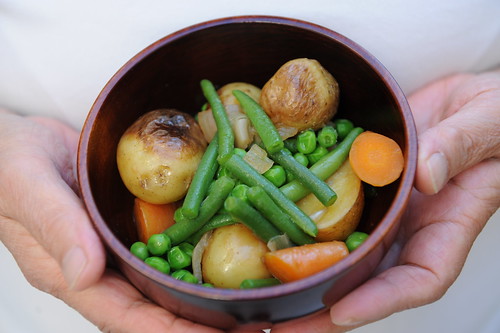when I was young and Makiko and her sister were small, Makiko’s father was sent to England by his company. After brief stays in London and Kent, we settled in Wokingham, a small town in Berkshire. (Nowadays I have heard it’s grown a lot bigger.) This was in the 1970s, when we had to go all the way to London to buy basic ingredients for Japanese cooking, like soy sauce. Making any kind of Japanese food was a struggle.
I grew some Japanese vegetables that I really missed, but had no chance of buying even in London at the time, in the garden of our rented house - things like shiso, mitsuba, shungiku, komatsuna, daikon and gobo (burdock). [See a dozen Japanese herbs and vegetables to grow - maki] I didn’t know anything about gardening, so when my gobo and daikon weren’t nice and straight, but were stubby ugly things with multiple roots, I wrote to my mother (international phone calls were so expensive then) in tears, asking her what to do. She wrote back so many times with detailed instructions - she was an avid gardener with a real green thumb. I still have those letters.
As I gradually adjusted to life away from Japan and my family, I became better at using local ingredients and adapting them to Japanese methods. This very simple summer braised vegetable dish is one recipe that I came up with during those years, that I still make every summer. It doesn’t even use dashi, which is standard in so many Japanese recipes. It uses vegetables that are available in Europe in early summer - new potatoes, green beans, peas, and carrots. The umami comes from the fresh young vegetables. Japanese cuisine is first and foremost about using seasonal ingredients, so to my mind, this is a very Japanese way of cooking.
Recipe: Simply Braised Spring Vegetables
This makes about 4 servings as part of a Japanese meal, to accompany rice, miso soup and one or two other dishes. You can also serve it alone or as a side dish to meat or fish.
To get the best flavor, it’s very important to use the freshest, preferably organic, vegetables you can find.
- 10-12 small new potatoes
- 2 small or 1 medium carrot
- 1 small onion
- About 1 cup of shelled green peas
- A large handful of green beans
- 1/2 Tbs. soy sauce (well she said ‘shu-shu’ (drizzle-drizzle), which I’m extrapolating to be about 1/2 tablespoon! - maki)
- Salt (good sea salt is preferred)
- Extra virgin olive oil, or other good flavorful oil (I use olive oil because you can get such wonderful olive oil here in the Provence, but you can also use sesame oil, walnut oil, and so on.)
Wash the new potatoes, and cut in half if they are big. Scrub and cut up the carrots into chunks. (Don’t peel the carrots - there’s a lot of flavor in the skin!) Dry both well in a kitchen towel.
Cut the onion in half, then slice against the grain (parallel to the root - as you would if you are cutting onion rings). Cutting against the grain ensures that the onions will cook faster.
Cut the tops and tails off the green beans, and cut in half. (If you have old fashioned green beans, take off the strings too.)
Heat up some oil in the bottom of the pan over medium-low heat. Put in the potatoes, and sauté while shaking occasionally until they are turning brown. Add the carrots about halfway through, and continue sautéing. This requires some patience, since it takes about 20 minutes or more.
Drain away any excess oil at this point. Add the sliced onions to the pan, and sauté some more until the onions are transparent and limp.
Add a small amount of water, just to about halfway up the potatoes. Add a tiny pinch of salt. Make an otoshibuta (drop lid) with a piece of aluminum foil, by crinkling it up so it fits on top of the vegetables in the pan, then poking a couple of holes in it with a chopstick. This otoshibuta ensures that the vegetables will cook evenly.
In the meantime, cook the green beans and peas in boiling salted water until crisp-tender. (Put the green beans in first, then add the peas for a couple of minutes.) Drain and set aside.
When the potatoes are tender (test by poking with a chopstick or fork) add the soy sauce, green beans and peas. Simmer for a few minutes longer while shaking the pan so that the flavors are evenly distributed. The water should be almost completely gone.
This is best served warm, but is also good at room temperature.
Optional: Add a little bit of sake or mirin near the end of the cooking process. This gives the vegetables a little added flavor and shine.
Tip: Sautéing vegetables in oil before stewing or braising
You will notice that this recipe calls for sautéeing the potatoes and onions in oil before braising. While most people know about sautéing onions and garlic to bring out the flavor, not many do this to other vegetables. Sautéing vegetables before cooking further brings out the flavor and sweetness in them. To prevent the final dish from becoming too oily, I always drain off any excess oil before proceeding further, as I did here.








0 ความคิดเห็น:
แสดงความคิดเห็น